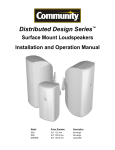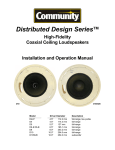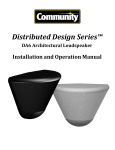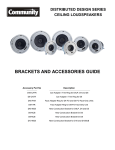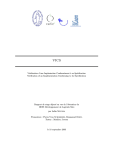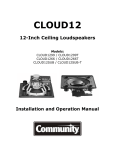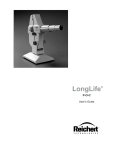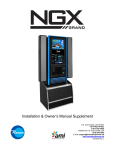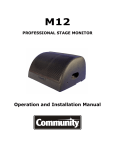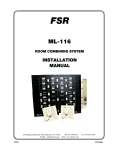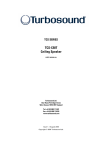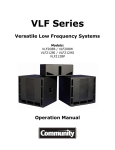Download Community C6-B Operating instructions
Transcript
Commercial Design Series™ Ceiling Loudspeakers Installation and Operation Manual Model C4LP C4 C6 C6-B C8 Loudspeaker Diameter 4.5” 114.3 mm 4.5” 114.3 mm 6.5” 165.1 mm 6.5” 165.1 mm 8.0” 203.2 mm Description 2-way, low pro ile 2-way, standard pro 2-way, standard pro 2-way, standard pro 2-way, standard pro ile ile ile (black) ile Introduction Thank you for selecting the Community Commercial Design Series™ of ceiling loudspeakers. Whether you chose them because they deliver exceptionally high quality sound, because they have predictable, uniform coverage so spaces are easy to lay out, because they are easy to install and save time, or because they are very competitively priced for such a high-performance loudspeaker, you can have con idence you made the right choice. The Commercial Design Series is built to satisfy safety agency standards, with quality assured by Community’s long history of building high-performance, durable loudspeakers for sound reinforcement and contracting applications. The Commercial Design Series is comprised of these models: Model C4LP C4 C6 C6-B C8 Diameter 4.5” 114.3 mm 4.5” 114.3 mm 6.5” 165.1 mm 6.5” 165.1 mm 8.0” 203.2 mm Response full-range full-range full-range full-range full-range Each model is delivered as a pair of loudspeakers, fully assembled, and including everything needed for standard installations. These are true coaxial loudspeakers. This means they have a real compression driver concentrically arranged so that the upper frequencies emerge through the center of the low-frequency driver’s magnetic structure and cone via a precisely tapered Tru-Phase™ high-frequency waveguide. This special construction provides consistent, wide dispersion right up to 16 kHz, all but eliminating high-frequency narrowing. You don’t have the re lection and diffraction problems at multiple frequencies found with “straight tube” coaxial loudspeakers, simple “whizzer-cone” loudspeakers, or front-mounted soft dome high frequency loudspeakers (typically found in ceiling speakers at this price point) that attempt to emulate a true coaxial design. Community does not use OEM or off-the-shelf utility loudspeakers in the Commercial Design Series. We designed these units from the coil formers to the back cans. We expended great effort to achieve a uniform voicing across Community Commercial Design Series all models in this series so that you can mix sizes to optimize the layout without having disconcerting changes in sound quality. If you require deeper low frequency response, you can add D10SUB or DS8SUB subwoofers from the Community Distributed Design Series of loudspeakers. Their high power handling, high sensitivity, and therefore higher overall output capacity allows this series of loudspeakers to deliver cleaner sound since they avoid drive-level related distortion. The Commercial Design Series saves you money in several ways. (a) Their powerful magnetic structures and ef icient coils ensure high output, which gives you more headroom per power ampli ier so you can use a smaller amp that will save you money. (b) These loudspeakers are very competitively priced and (c) Community designed this series with placethrough-the-cutout Tile Support Bridge Rails and their snap-on spacers, and Drop-Stop™ installation assistant tabs. Since the loudspeaker is pre-assembled in the back-can with its crossover network, and prewired to an external Euro connector, the installer simply inserts the units into the ceiling in one smooth push of the hand and they snap in place. They cannot then fall out, thus leaving both hands free to tighten the two clamp actuator screws, adjust the front-face power setting dial, and snap on the grille. The wiring cover plate also serves to clamp non-conduit carried wires, and the cover does not need to be removed for access... it just swings clear. Because one person on a ladder is easily able to install the loudspeaker in the ceiling, redundant labor is eliminated. Overall, this saves a tremendous amount of time and labor during the installation. All models in this series accommodate 8-ohm as well as 70V/100V applications. We urge you to read these instructions carefully and familiarize yourself with the features and installation methods before you begin the job. If you have any questions or concerns, please contact Community. Installation and Operation Manual Page 2 Table of Contents Important Safety Instructions . . . . . . . . . . . . . . . . . . . . . . . L’information de Sûreté Importante . . . . . . . . . . . . . . . . . . . Unpacking and Inspection . . . . . . . . . . . . . . . . . . . . . . . . . Full Ceiling Loudspeaker Assembly (Typical) . . . . . . . . . . . . . . Optional Accessories . . . . . . . . . . . . . . . . . . . . . . . . . . . . . . Speciϐications. . . . . . . . . . . . . . . . . . . . . . . . . . . . . . . . . . Component Identiϐication . . . . . . . . . . . . . . . . . . . . . . . . . Wiring . . . . . . . . . . . . . . . . . . . . . . . . . . . . . . . . . . . . . . Power Determination. . . . . . . . . . . . . . . . . . . . . . . . . . . . . . Installation in back cans without conduit . . . . . . . . . . . . . . . . . Installation of conduit to the loudspeaker . . . . . . . . . . . . . . . . Installing the Loudspeaker in the Ceiling . . . . . . . . . . . . . . . General . . . . . . . . . . . . . . . . . . . . . . . . . . . . . . . . . . . . . Procedure (for suspended ceiling) . . . . . . . . . . . . . . . . . . . . . Dry-Wall Ceiling Installation. . . . . . . . . . . . . . . . . . . . . . . . . . Details for Pre-Installation in a New Drywall Ceiling . . . . . . . . . Inserting the Loudspeaker Assembly into the Back Can. . . . . . . . Loudspeaker Tap Setting . . . . . . . . . . . . . . . . . . . . . . . . . . Painting the Loudspeaker . . . . . . . . . . . . . . . . . . . . . . . . . Type of Paint . . . . . . . . . . . . . . . . . . . . . . . . . . . . . . . . . . . Painting Process . . . . . . . . . . . . . . . . . . . . . . . . . . . . . . . . . Safety Cabling the Grille. . . . . . . . . . . . . . . . . . . . . . . . . . . Warranty Information and Service . . . . . . . . . . . . . . . . . . . Transferable Warranty “(Limited)” Valid in the USA Only. . . . . . . . . . . . . . . . . . . . . . . . . . . . . . . . . . . . . . . . . . . . . . . . . . . . . . . . . . . . . . . . . . . . . . . . . . . . . . . . . . . . . . . . . . . . . . . . . . . . . . . . . . . . . . . . . . . . . . . . . . . . . . . . . . . . . . . . . . . . . . . . . . . . . . . . . . . . . . . . . . . . . . . . . . . . . . . . . . . . . . . . . . . . . . . . . . . . . . . . . . . . . 4 . . . . . . 5 . . . . . . 6 . . . . . . .7 . . . . . . .7 . . . . . . 8 . . . . . .10 . . . . . .11 . . . . . . 11 . . . . . . 11 . . . . . . 11 . . . . . .13 . . . . . . 13 . . . . . . 13 . . . . . . 15 . . . . . . 16 . . . . . . 16 . . . . . .17 . . . . . .18 . . . . . . 18 . . . . . . 18 . . . . . .19 . . . . . .20 . . . . . . 20 Table of Figures Figure 1. Full Ceiling Loudspeaker Assembly Package Contents (Typical) . . . . . . . . . . . 6 Figure 2. Optional Accessories . . . . . . . . . . . . . . . . . . . . . . . . . . . . . . . . . . . . . . . 7 Figure 3. C4LP Dimensions . . . . . . . . . . . . . . . . . . . . . . . . . . . . . . . . . . . . . . . . . 9 Figure 4. C4 Dimensions . . . . . . . . . . . . . . . . . . . . . . . . . . . . . . . . . . . . . . . . . . . 9 Figure 5. C6 & C6-B Dimensions . . . . . . . . . . . . . . . . . . . . . . . . . . . . . . . . . . . . . . 9 Figure 6. C8 Dimensions . . . . . . . . . . . . . . . . . . . . . . . . . . . . . . . . . . . . . . . . . . . 9 Figure 7. Component Part Identi ication. . . . . . . . . . . . . . . . . . . . . . . . . . . . . . . . 10 Figure 8. Non-Conduit Guided Wiring to Can and Wire Restraint. . . . . . . . . . . . . . . . 12 Figure 9. Conduit for Protected Wiring to Can . . . . . . . . . . . . . . . . . . . . . . . . . . . . 12 Figure 10. Cutout Template Dimensions. . . . . . . . . . . . . . . . . . . . . . . . . . . . . . . . 13 Figure 11. Positioning the Tile Bridge Support Rails and Bridge Rail Spacer Bars . . . . . 13 Figure 12. Position of Loudspeaker Relative to Bridge Support Rails During Installation 14 Figure 13. Drop-Stop Tabs Snap Out Over Bridge Support Rails . . . . . . . . . . . . . . . . 14 Figure 14. Turning the Loudspeaker Clamp Actuators Locks the Unit into the Ceiling. . . 14 Figure 15. Mounting Clamps Shown Gripping Tile Support Bridge Rails . . . . . . . . . . . 14 Figure 16. New Installation in an Existing Drywall Ceiling . . . . . . . . . . . . . . . . . . . . 15 Figure 17. New Construction Bracket for Drywall or Lath-and-Plaster Installations. . . . 16 Figure 18. Setting Loudspeaker Tap . . . . . . . . . . . . . . . . . . . . . . . . . . . . . . . . . . 17 Figure 19. Grille Safety Clip and Line (left) Should Look Like This (right) When Attached . 19 Community Commercial Design Series Installation and Operation Manual Page 3 Important Safety Instructions Always follow these basic safety precautions when using or installing Commercial Design loudspeakers and accessories: • Read these instructions. • Keep these instructions. • Heed all warnings. • Follow all instructions, particularly those pertaining to rigging, mounting, hanging and electrical connections. • Do not use this apparatus near water. • Clean only with dry cloth. • Do not block any ventilation openings. Install in accordance with the manufacturer’s instruction. • Do not install near any heat sources such as radiators, heat registers, stoves, or other apparatus (including ampli iers) that produce heat. • Only use attachments/accessories that are speci ied and approved by the manufacturer. • Refer all servicing to quali ied service personnel. Servicing is required when the apparatus has been damaged in any way, such as power-supply cord or plug is damaged, liquid has been spilled or objects have fallen into the apparatus, the apparatus has been exposed to rain or moisture, does not operate normally, or has been dropped. The terms caution, warning, and danger may be used in this manual to alert the reader to important safety considerations. If you have any questions or do not understand the meaning of these terms, do not proceed with installation. Contact your local dealer, Community Commercial Design Series distributor, or call Community directly for assistance. These terms are de ined below: CAUTION: describes an operating condition or user action that may expose the equipment or user to potential damage or danger. WARNING: describes an operating condition or user action that will likely cause damage to the equipment or injury to the user or to others in the vicinity. DANGER: describes an operating condition or user action that will immediately damage the equipment and/or be extremely dangerous or life threatening to the user or to others in the vicinity. ____________________________________________________ WARNING: To reduce the risk of ire or electric shock, do not expose this apparatus to rain or moisture. These servicing instructions are for use by quali ied service personnel only. To reduce the risk of ire or electric shock do not perform any servicing other than that contained in the operating instructions unless you are quali ied to do so. The loudspeakers described in this manual are designed to be installed or suspended for maximum acoustical performance using the included hardware. It is essential that all installation work involving the suspension of these loudspeaker products be performed by competent, knowledgeable persons who understand safe rigging practices. Severe injury and/or loss of life may occur if these products are improperly installed. Please read the section on wiring and installation for additional information. Installation and Operation Manual Page 4 L’information de Sûreté Importante PRECAUTION: Veuillez toujours suivrent ces mesures de sécurité de base lors de l’utilisation ou lors de l’installation des haut-parleurs Commercial Design et de ces accessoires: • Lisez et Gardez les instructions. • Observez tous les avertissements. • Suivez toutes les instructions, particulierement ceux concernant le calage, support, montage et raccordements électriques. • Ne pas utiliser cet appareil près de l’eau. • Nettoyez seulement avec un tissu sec. • Ne pas bloquer les ouvertures de ventilation. Installer conformément aux instructions du fabricant. • Ne pas installer près des sources de chaleur comme les radiateurs, les cuisinières, foyers ou autres appareils (y compris les ampli icateurs) qui peuvent produire de la chaleur. • Utilisez seulement les accessoires qui sont spéci iés et approuvés par le fabricant. • Référez tout entretient au personnel qualiié de service. Ceci est exigé quand l’appareil a été endommagé de quelque façon, incluant le il d’alimentation et ou l’embout du il a été endommagé, des liquides ont été renversés ou des objets sont tombé à l’intérieur de l’appareil, l’appareil a été exposé à la pluie ou l’humidité, l’appareil ne fonctionne pas normalement ou a été échappé. Les termes attention, avertissement, et danger peut être utilises dans ce manuel pour alerter le lecteur aux considérations importantes de sûreté. Si vous avez des questions ou ne comprenez pas la signi ication de ces termes, ne procédez pas à l’installation. Contactez votre detaillant, distributeur, ou Community directement pour assistance. Les termes sont dé inies ci-dessous: Community Commercial Design Series ATTENTION: décrit une condition de fonctionnement ou une action d’utilisateur qui peuvent exposer l’équipement ou l’utilisateur aux dommages potentiels ou au danger. AVERTISSEMENT: décrit une condition de fonctionnement ou une action d’utilisateur qui peuvent causer des dommages probable à l’équipement et/ou à l’utilisateur et à ceux se trouvant à proximité. DANGER: décrit une condition de fonctionnement ou une action d’utilisateur qui endommageront immédiatement l’équipement et/ ou seront extrêmement dangereuses et qui peut représenter un danger pour la vie à l’utilisateur et à ceux se trouvant à proximité. ___________________________________________________ AVERTISSEMENT: Pour réduire le risque de feu ou de décharge électrique, ne pas exposer cet appareil à la pluie ou l’humidité. Ces instructions d’entretient sont pour l’usage d’un personnel de service quali ié seulement. Pour réduire le risque de feu ou de décharge électrique n’exécutez aucun entretient autrement que ce qui est contenu dans les instructions d’opérations à moins que vous êtes quali ié pour le faire. Les haut-parleurs décrits en ce manuel sont conçus pour être installe les quincaillerie inclus, moyens, et méthodes de calage dans certaines applications. Il est essentiel que tout le travail d’installation impliquant la suspension de ces produits de haut-parleur soit effectué de facon securitaire par des personnes compétentes et bien formées dans les methodes de calage. Des blessures graves et/ou des pertes humaines peuvent se produire si ces produits sont incorrectement installés. Veuillez lire la section sur le câblage et l’installation pour des informations supplémentaires. Installation and Operation Manual Page 5 EC STATEMENT OF CONFORMITY This document conϐirms that the range of products of Community Professional Loudspeakers bearing the CE label meets all of the requirements in the EMC directive 89/336/EEC laid down by the Member States Council for adjustment of legal requirements. Furthermore, the products comply with the rules and regulations referring to the electromagnetic compatibility of devices from 30-August-1995. The Community Professional Loudspeaker products bearing the CE label comply with the following harmonized or national standards: DIN EN 55013:08-1991, DIN EN 55020:05-1995, DIN EN 550821:03-1993 The authorized declaration and compatibility certiϐication resides with the manufacturer and can be viewed upon request. The responsible manufacturer is the company: Community Light & Sound 333 East 5th Street Chester, PA 19013 USA TEL: 1-610 876-3400 / FAX: 1-610 874-0190 Chester, PA USA - October 2012 Safety Agency Compliance 4001450 Conforms to UL1480 Standard Conforms to UL2043 Standard Certiϐied to CSA C22.2 No. 60065 Standard Additional Compliance Information Suitable for use in air handling spaces per NFPA70 National Electrical Code 2008 Article 300.22(c)(2) and NFPA 90 Installation of Air Conditioning and Ventilation Systems 2009 Article 4.3.11.2.6.5. SUITABLE FOR USE IN AIR HANDLING SPACES Unpacking and Inspection Community Commercial Design loudspeakers are engineered and manufactured to be rugged and they are carefully packed in sturdy cartons. However, it is wise to thoroughly inspect each unit after it has been removed from the packaging, as damage could occur during shipping. Please note that once the shipment has left your dealer or the Community factory, the responsibility for damage is always borne by the freight company. If damage has occurred during shipping, you must ile a claim Community Commercial Design Series directly with the freight company. It’s very important to contact the freight company as soon as possible after receiving your shipment, as most freight companies have a short time limit within which they will investigate claims. Make sure to save the carton and the packing material, as most claims will be denied if these materials are not retained. Your Community dealer and the factory will try to help in any way they can, but it is the responsibility of the party receiving the shipment to ile the damage claim. Installation and Operation Manual Page 6 Full Ceiling Loudspeaker Assembly (Typical) (Models: C4LP, C4, C6, C6-B and C8) • Ceiling Loudspeaker Assembly (Qty 2) • Tile Support Bridge Rails (Qty 4) • Bridge Rail Spacers (Qty 4) • • • • Grilles (Qty 2) Cut-out template (can-sized) (Qty 1) Paint Masks (Qty 2) Flat screwdriver (Qty 1) (for screws, connectors and to help remove the grille) Grilles Paint Masks Loudspeakers (with integral back cans) Tile Support Bridge Rails Support Br Bridge Rail Spacers Spac Cut-out Template Flat screwdriver Figure 1. Full Ceiling Loudspeaker Assembly Package Contents (typical) Optional Accessories Community offers helpful optional accessories that are not included with the basic packages. Please be sure to order these parts separately if you need them. Can Adapter Trim Rings allow you to mount an entire Commercial Design loudspeaker assembly into an existing industry back can that is already in the ceiling from a previous installation. If you’re performing a retro it, you will want to order the type of adapter you need in the size suitable for the loudspeaker. The Can Adapter Ring can be used as a Trim Ring, allowing you to mount a Commercial Design loudspeaker assembly into an existing but over-size ceiling cutout hole. When used as a trim ring, white rubber hole plugs (included) ill the 4 countersink indents. A New Construction Bracket is available for installing loudspeakers in new construction before drywall or plaster is put in place. The drywall typically is cut with a router-type tool or laser guided cutter in which case the bracket hole will serve as a cutout guide. New Construction on Bracket Can Adapter/Trim Ring Rin Note: Some models share a common accessory item, as indicated in the chart. Figure 2. Optional Accessories Community Commercial Design Series Installation and Operation Manual Page 7 Speciϐications Model C4LP C4 C6/C6-B C8 Ceiling Loudspeaker Type Full Range Coax Full Range Coax Full Range Coax Full Range Coax Description 4.5” Low Pro ile 4.5” Standard 6.5” Standard 8.0” Standard Max Input Power Rating (8 ohms, continuous RMS) 60 Watts 60 Watts 60 Watts 60 Watts Operating Range (-10 dB) 90Hz-13,500Hz 75Hz - 13,500Hz 70Hz - 13,500Hz 65Hz - 13,500Hz Sensitivity (1 W/1 meter) 91 dB SPL 91 dB SPL 91 dB SPL Maximum Output (8 ohms) 109 dB SPL 109 dB SPL 109 dB SPL 109 dB SPL Nominal Impedance 8 ohms 8 ohms 8 ohms 8 ohms 91 dB SPL Maximum Voltage at Driver (RMS) 21.91 V (60 W) 21.91 V (60 W) 21.91 V (60 W) 21.91 V (60 W) Maximum Current (70 V / 8 ohm) 0.11 A / 2.74 A 0.11 A / 2.74 A 0.43 A / 2.74 A 0.43 A / 2.74 A Nominal -6 dB Beamwidth (500 Hz to 6 kHz) 140° conical 140° conical 120° conical 120° conical HF Compression driver (exit) LF driver (dia.) .75”/19.4 mm 4.5”/114.3 mm .75”/19.4 mm 4.5”/114.3 mm .75”/19.4 mm 6.5”/165.1 mm .75”/19.4 mm 8”/203.2 mm LF loudspeaker (Voice Coil dia.) 1”/ 25.4 mm 1” / 25.4 mm 1” / 25.4 mm 1” / 25.4 mm Input Connection Connector for two pair of 2-wire leads, non-interrupt jumpered. Internal Connection Euroblock Quick Disconnect Available 70V Taps (watts) Available 100V Taps (watts) Low Impedance 8-4-2-1 16-8-4-2 8 ohms 8-4-2-1 16-8-4-2 8 ohms 30-15-7.5-3.75 NC†-30-15-7.5 8 ohms 30-15-7.5-3.75 NC†-30-15-7.5 8 ohms Knockout Strain Relief (Qty) 1 1 1 1 Seismic Safety Attachment Points (# of steel mounting clips) 2 2 2 2 Enclosure Zinc Plated Steel Grille Included Accessories (Per Pair) Powder Coated Steel Grille with Safety Metal Clip (4) Bridge Rails, (4) Spacer Bars, (2) Grilles, (2) Paint Masks, Cut-out Template, Screwdriver Optional Accessories Retro it Can Adapter/Trim Ring, New Construction Bracket Dimensions: Face Diameter Depth from Bafϐle back 8.31” (211 mm) 3.61” (91.7 mm) 8.31” (211 mm) 5.50” (139.7 mm) 9.80” (240 mm) 11.30” (287 mm) 6.49” (164.8 mm) 7.55” (191.8 mm) Cutout Diameter 7.36 “ (187 mm) 7.36 “ (187 mm) 8.86 “ (225 mm) 10.35 “ (263 mm) †The designation NC means do not use this setting when connected to a 100-volt system as it would draw too much power. NC means “No-Connect,” really “do not connect.” Community Commercial Design Series Installation and Operation Manual Page 8 Figure 3. C4LP Dimensions Figure 4. C4 Dimensions Community Commercial Design Series Figure 5. C6/ C6-B Dimensions Figure 6. C8 Dimensions Installation and Operation Manual Page 9 Component Identiϐication Combination terminal block cover and cable strain relief clamp Input Terminal Block 3/4” (19 mm) Knockout strain relief on terminal block cover (with conduit installed) Loudspeaker Locking Clamp (shown deployed) Injection-molded Can-Locking Clamp (2) Drop-Stop Installation Assistant Tab (2) Bridge Rail Spacer Bar (x2) Seismic Safety Tab (x2) Drop-Stop Installation Assistant Tab (x2) Injection-Molded Locking Clamp (x2); shown retracted U-Channel Tile Support Bridge Rails Grille (shown installed onto loudspeaker l face) Low Impedance / 70V & 100V Transformer Tap Switch Metal safety clip and high-impact mono ϐilament nylon loops that secure grille to loudspeaker face Mounting screw holes on optional can adapter/trim ring Figure 7. Component Part Identiϐication Community Commercial Design Series Installation and Operation Manual Page 10 Wiring This manual will serve to assist in wiring and physically mounting Commercial Design Series loudspeakers. The directions include assistance to those installers using a complete Community package of loudspeakers and accessories, including the integral back cans, grilles, tile rails and so forth. We include instructions for use of optional Community Commercial Design Series retro it adapters so that Community Commercial Design Series loudspeakers can be mounted in other manufacturer’s cutouts. If accessory products from a different manufacturer are used, please refer to the installation manuals supplied with those products. Power Determination As detailed subsequently, there is no need to specially select different wire terminals for 8-ohms or for various 70-volt and 100volt power taps. Instead, a face-mounted tap switch allows you to make this selection. Once the loudspeaker is mounted correctly in the ceiling, set the tap switch to the appropriate tap setting before any audio is passed through the loudspeaker. Do not change the setting on the tap switch while the loudspeaker is in use. Note: All electrical installation connections for loudspeaker lines are subject to all applicable governmental building and ϔire codes. The selection of appropriate electrical hardware to interface with the Commercial Design Series loudspeaker lies solely with the installation professional. Community recommends that an appropriately licensed engineer, electrician, or other qualiϔied professional identify and select the appropriate conduit, ϔittings, wire, etc. for the installation. Installation in back cans without conduit Installation of conduit to the loudspeaker The only tool required is a screwdriver, which is provided in the loudspeaker package. Commercial Design integral back cans include a swivel-out terminal access cover that also serves as a cable clamp when tightened in place. The terminal block in the can’s outer recess has two (+) connections and two (-) connections. If you are only connecting one (dual conductor) cable, you can use either (+) and (-) terminal, as illustrated on the next page in Figure 8. If you’re daisy-chaining a cable to the next loudspeaker, you may connect the next cable to the remaining (+) and (-) terminals. There is no need to connect jumpers or try to stuff two wires into one terminal block port because each pair of (+) and each pair of (-) terminals is directly jumpered together on the input connector. Required tools: • (1) Hammer and knockout punch tool • (1) Step-bit for adjusting knockout diameter (optional) • Safety glasses, gloves and other personal safety gear are recommended as this process involves striking metal parts and chipping away debris around the knockouts. Community Commercial Design Series 1. All Commercial Design Series loudspeaker back cans have a dual-diameter knockout strain relief itting on the top cover. 2. The knockout strain relief port is opened with a hammer and punch using the same techniques for removing knockouts in standard electrical boxes. Installation and Operation Manual Page 11 3. Insert appropriate ittings and tighten suf iciently for wire path concealment and strain relief, in accordance with applicable codes. Terminal Block (6” model) 4. You can use lexible or rigid conduit (as required by local electrical codes). Cover/strain relief plate swiveled into closed position and secured to clamp the cable ϐirmly. Note the 3/4 inch (19 mm) knockout in the cover that may be used for conduit. Terminal Block showing wire connections to the block for a single cable (not daisy-chained) Built-in cable strain relief Figure 8. Non-Conduit Guided Wiring to Can and Wire Restraint (Only use this method when permitted by applicable building and electrical codes!) Conduit ϐitted to the top cover plate of the can, which has a knockout strain relief for this purpose. Figure 9. Conduit for Protected Wiring to Can Community Commercial Design Series Installation and Operation Manual Page 12 Installing the Loudspeaker in the Ceiling General Lay out the loudspeaker locations according to the requirements of the speci ic installation and in compliance with applicable safety and building codes. It is beyond the scope of this manual to provide guidance in this area. Community does, however, offer our Forecaster HD Distributed Ceiling System Software to assist you in distributed loudspeaker system design. Please visit the Product Selection area of Community’s website for this software. We also encourage using the provided seismic safety tabs to secure the back cans to the building structure. Again, please be guided by applicable building codes here; Community cannot provide detailed rigging instructions due to the wide global variations in such codes and practices. Figure 10. Cutout template dimensions Bridge Rail Spacer Bars Procedure (for suspended ceiling) Note: The optimum situation for installation is into a ceiling where the suspension grid is installed and the tiles have not yet been placed. Community designed this series to facilitate installation into an already-placed ceiling, and we are writing the instructions to conform to this more restrictive condition. So when we say something like, “pass the tile bridge support rails through the loudspeaker cutout,” and in your situation the adjacent space is unobstructed, of course you should feel free to use the more sensible alternative and just drop the rails into place. 1. Mark the hole location on the ceiling tiles and, using the cutout template provided with your Commercial Design Series loudspeakers, cut a hole to the precise size. See Figure 10. 2. Insert the Tile Bridge Support Rails through the can cutout and position them across the rails on either side of the cutout, approximately as far apart as the Bridge Rail Spacer Bars. Then insert the pair of spacer bars and clip them over the tile bridge support rails as shown in Figure 11. Community Commercial Design Series Tile Bridge Support Rails Figure 11. Positioning the Tile Bridge Support Rails and Bridge Rail Spacer Bars 3. Make sure mounting clamps are parked tight against sides of back can before sliding the loudspeaker into the hole, aligning it so that the mounting clamps are nearest to the two bridge support rails, labels on the loudspeaker face indicate the position of the mount clamps and the required alignment. Before sliding the back can into the ceiling hole, slightly bend each Drop-Stop™ tab outward from the back can 1/2 inch (12 mm). When you press the can fully into place, the two spring-loaded Drop-Stop™ tabs will spread atop the bridge support rails, and you may hear them “snap” into position; you can now continue without having to hold the loudspeaker in place. The Drop-Stop tabs are Installation and Operation Manual Page 13 designed to drop into the Tile Bridge support rails channels, they will not work properly if mis-aligned. See note and Figures 12 and 13 on the next page. Note: If you’re using loose wires, rather than conduit, ϔirst connect the wires to the terminal block atop the loudspeaker assembly, and secure them with the top cover/strain relief, before installing the can through the cutout and into place. 4. Locate the two Phillips-head actuators around the perimeter of the loudspeaker’s front lange (see Figure 14). Using a #2 Phillips screwdriver twist each actuator clockwise until you feel resistance as the clamps press against the ceiling bridge rails (Fig. 15). Figure 14. Turning the two loudspeaker clamp actuators clockwise securely locks the unit into the ceiling. Figure 12. Position of Loudspeaker Relative to Bridge Support Rails During Installation Figure 13. Drop-Stop Tabs (highlighted) Snap Out Over Bridge Support Rails (Temporarily holds unit in place even before you secure it with the mounting clamps) Community Commercial Design Series Figure 15. Mounting Clamps Shown Gripping Tile Support Bridge Rails After the Clamp Actuators Have Been Tightened. Installation and Operation Manual Page 14 Dry-Wall Ceiling Installation. There are three basic ways to install a Community Commercial Design Series loudspeaker assembly into a drywall ceiling (a.k.a. sheet rock or gypsum board). Some are for new construction, others for retro it to existing construction. We recommend some methods over others and of course the choice is yours. A. The preferred method for new installations is to use the optional New Construction Bracket, pre-installing it directly to the supporting beams before the sheet rock is applied. Multiple small holes on wings to either side of the main cutout hole allow the installer to use screws or nails to secure the ring to the straddling beams. See the following subsection for step-bystep details and variations. B. An alternative method for new installations – where the ceiling has already been completed – is to use the Tile Bridge Support Rails. While there are in fact no truss members across which the rails it, nonetheless they will distribute the weight of the loudspeaker assembly across a greater area and will thus avoid sagging or having the mounting clamps cut into the ceiling that might otherwise occur over time. You can cut the hole using the provided template or using a New Construction Bracket as a cutting guide, even though this bracket won’t be used for the actual installation. It’s then easy to pass Community Commercial Design Series the Tile Bridge Support Rails through the cutout, then the Spacers, and align the loudspeaker mounting clamps so they rest top of the rails. Refer to Figure 15 on page 14 and to Figure 16 here. Figure 16. New Installation in an Existing Drywall Ceiling Use the Tile Bridge Support Rails & Spacers C. Retroϔit an entire Community Commercial Design Series Loudspeaker Assembly into an existing oversized ceiling cutout using a corresponding Commercial Design Series CATR Can Adapter Trim Ring. Important! Do not mount the loudspeaker into any material without using either the New Construction Bracket or the Bridge Support Rails! Installation and Operation Manual Page 15 Details for Pre-Installation in a New Drywall Ceiling Inserting the Loudspeaker Assembly into the Drywall Ceiling Optional New Construction Brackets are available for installing loudspeakers in new construction before drywall or plaster is put in place. See Figure 17, and refer to the chart of Figure 2 on page 7 for sizes and model numbers. 1. Bring the wiring from the ceiling to the top of the can and attach it to the terminal block (see the next Section of this manual for details). Secure the wiring with the top plate/ strain relief clamp. Figure 17. New Construction Bracket for Drywall or Lath-and-Plaster Installations The New Construction Brackets support the loudspeakers in plaster/dry wall ceilings. Multiple holes in the bracket’s two “ears” permit convenient attachment to nearby ceiling beams. The drywall typically is cut with a router-type tool, in which case the bracket central hole will serve as a cutout guide for the router bit. Always attach a safety cable to one or both seismic safety tabs in all installations. Failure to do so could result in injury or even death in the event of a failure of the primary mounting support system. Community Commercial Design Series 2. Before sliding the back can into the ceiling hole, slightly bend each Drop-Stop installation assistant tab outward from the back can 1/2 inch (12 mm). Slide the loudspeaker into the hole. When pressing the unit fully into place, the two Drop-Stop tabs will spread atop the tile support bridge rails, and you may hear them “snap” into position; you can now continue without having to hold the back can in place. The illustration in Figure 13 on page 14 shows how the Drop-Stop tabs work, and is equally applicable with New Construction Bracket installations in drywall ceiling 3. Locate the two Philips-head can clamp actuators around the perimeter of the front lange, and using a #2 Phillips screwdriver twist each actuator clockwise until you feel tension as the clamps securely lock the loudspeaker into the ceiling (refer to Figures 13 and 14 on page 14). These clamps open fully to 2.35” (59.6 mm), but we allow at least 0.60” (15.2 mm) to grab the Tile Bridge Support Rail atop the ceiling. Loudspeakers leave the Community factory with these clamps fully open so that approximately 1.75” (44.4 mm) thick ceilings can be accommodated. Installation and Operation Manual Page 16 Loudspeaker Tap Setting You can use a standard #2 or #3 Phillips or a medium slot-blade screwdriver (not the one provided with the loudspeaker kit), or just press thumb irmly, and twist to adjust the power control dial on the front face of the loudspeaker baf le. As shown in Figure 19, you can make any of ive different settings, although the dial has dual calibrations so at irst glance it appears to have ten settings. The 8-ohm position is the same on both sides and is for a low impedance connection. On the lower-left side of the power tap control shown in the close-up on Figure 19 are the power values for 100-volt connections, and on the upper right side are the power values for 70-volt connections. Note: The letters NC mean “no-connect” but they do not actually break a connection. DO NOT USE this setting if you’re using a 100-volt distribution scheme as the loudspeaker may draw excessive power; it corresponds to the highest power that can be drawn with a 70volt source. Face-mounted, screwdriver-adjustable loudspeaker power / voltage setting dial. Enlarged detail of typical adjustor dial Caution: Set the tap switch initially prior to applying audio, and only change the switch setting while the audio ampliϔier is shut off. This control makes it very easy and fast to balance an installation since there is no need to drop the loudspeakers out of their back cans and move wires to different terminals. Figure 18. Setting Loudspeaker Tap Community Commercial Design Series Installation and Operation Manual Page 17 Painting the Loudspeaker These loudspeakers’ textured white inish complements most decors and does not require further painting. However, if the interior design requires a custom loudspeaker inish, these loudspeakers are easy to paint. It’s best to paint the baf le before installation. In cases where it needs to be inished along with the ceiling, the loudspeaker baf le can be painted after mounting in the ceiling. Note: The paint masks provided by Community are intended to PREVENT the loudspeakers from receiving any paint. Type of Paint The loudspeaker’s ABS plastic baf le accepts almost any type of latex or oil based paint. We recommend application of two coats. Painting Process Follow this procedure to obtain the best results: 1. Clean the baf le with a light solvent such as mineral spirits, rubbing the baf le with a lightly dampened cloth. Do not use abrasives such as sandpaper or steel wool. Caution: Use only light mineral spirits thinner as a cleaner. NEVER use gasoline, kerosene, acetone, methyl ethyl ketone (MEK), paint thinner, harsh detergents or other chemicals. These chemicals and agents may permanently damage the loudspeaker and some are also toxic and highly lammable. Community Commercial Design Series 2. Mask the loudspeaker so that the surround, cone and center area will not receive any paint. If the loudspeaker is already in the ceiling, you may wish to mask the ceiling as well. Use a low-tack painter’s tape (typically blue in color) to avoid damaging the loudspeaker surround when the tape is removed. We advise against using conventional masking tape and NEVER use duct tape in this application; these kinds of tape generally leave adhesive residue that can be dif icult to remove and that may actually cause damage. 3. After cleaning, apply two or more two thin coats of either latex or oil-based paints. Latex paint will adhere better if an oil-based primer is used irst. Apply the paint with a roller or brush, or spray it on. 4. The grille should be painted separately, and when it is not in place on the loudspeaker. We further recommend that you remove the grille’s internal cloth mesh, then spray paint the grille assembly. Avoid using a roller or brush to paint the grille as its metal perforated holes may become clogged with paint, which degrades sound quality and also may attenuate the sound. Reinstall the internal cloth mesh (or if damaged install a new cloth mesh). Installation and Operation Manual Page 18 Safety Cabling The Grille Note: Some codes now require that the grille have a safety cable; your local codes may vary. Community makes it easy to comply with an included security cable system, as detailed in Steps 1 through 3 below. 1. Once the loudspeaker is secured in the ceiling, you can attach the safety cable between the grille and loudspeaker. There is a nylon mono ilament loop attached to the grille and looped through a metal clip. Another mono ilament line is located inside the bass re lex port of the face of the loudspeaker. Use the metal clip to link these two mono ilament loops. See Figure 18. 2. Carefully lower the grille until the cable holds it, and let go. It should hang harmlessly from the mono ilament line. 3. If you’re proceeding with setup, you can leave the grille hanging so you can adjust the power setting as noted on the next page. Otherwise, install the grille into position on the face of the loudspeaker baf le. Figure 19. Grille Safety Clip and Line (left) Should Look Like This (right) When Attached. Community Commercial Design Series Installation and Operation Manual Page 19 Warranty Information and Service Transferable Warranty “(Limited)” Valid in the USA Only The Commercial Design Ceiling Loudspeaker systems are designed and backed by Community Professional Loudspeakers. For complete warranty information within the USA please refer to the Warranty Card enclosed with the product. Please call 610-876-3400 to locate your nearest Authorized Field Service Station. For Factory Service call 610-876-3400. You must obtain a Return Authorization (R/A) number prior to the return of your product for factory service. Warranty Information and Service for Countries Other Than the USA To obtain speci ic warranty information and available service locations for countries other than the United States of America, contact the authorized Community Distributor for your speci ic country or region. Community Professional Loudspeakers 333 East Fifth Street, Chester, PA 19013-4511 USA Tel: 1-(610) 876-3400 | Fax: 1-(610) 874-0190 www.communitypro.com © 2012 All Rights Reserved 26NOV2012




















